
Page 28: of Maritime Reporter Magazine (April 2014)
Offshore Edition
Read this page in Pdf, Flash or Html5 edition of April 2014 Maritime Reporter Magazine
28 Maritime Reporter & Engineering News ? APRIL 2014 $80,500 + $20,000). This establishes a range within which both sides should ra-tionally be willing to settle the case.The time value of money also must be considered. A cash settlement to- day is more valuable to a plaintiff than an equivalent judgment two years from now, and any settlement analysis should take this factor into account.The Importance of Critical Analysis Of course, this kind of analysis is only as good as the data that goes into it. Most importantly, if a party is overly optimis- tic or pessimistic about the chances of an event occurring, then its calculation of the expected value of the case will be correspondingly skewed. In most cases, this kind of analysis is an evolv-ing process. At the beginning of a case the parties may not have all the facts or they may not have had an opportunity to research all the critical legal issues at stake. Moreover, in a highly complex case it may not be possible at the begin-ning of the matter to anticipate all the developments that will unfold as parties are added, motions Þ led, counterclaims asserted, and so forth. As the case devel- ops, therefore, it is critical to revisit the analysis to see how those developments impact the claim?s expected value. The Soft FactorsEconomic analysis is a very useful way to look at a claim from a ?business? perspective, but in many cases there are other factors that may materially alter a party?s assessment of its ?settlement val- ue.? A claim involving serious injury or death, for instance, may be charged with emotional factors that strongly inß uence a plaintiff?s assessment of what it is will- ing to accept in settlement.Risk acceptance or avoidance is of-ten another signiÞ cant factor. It is one thing to say that a coin toss is a 50/50 endeavor, but in any given coin toss one side wins and the other side loses, and a party may be willing to pay a premium or take a discount in exchange for the certainty of avoiding a total loss. More-over, psychological studies have shown that a plaintiff may in some instances be willing to take an economically ?irratio-nal? risk where there is a low probability of success but a very high potential re-ward. (You might call this the lottery ef- fect). And conversely, a defendant may be willing to pay an ?irrationally? high amount to avoid a high value but low probability judgment, especially where such a judgment would be economically catastrophic.Commercial considerations often sig-niÞ cantly impact a party?s settlement threshold. For instance, a defendant may be willing to pay a premium to re-solve a claim that is interfering with oth-er business objectives, such as a merger or a public offering of shares. A plaintiff may be willing to offer a discount in or- der to fund its ?war chest? to allow it to more vigorously pursue claims against other parties.Personality traits and ?aspirations? of the negotiating parties may also play a signiÞ cant role in how a party assesses the settlement value of a case. Pride and ego are always wildcards, and if the person making settlement decisions for one party has a personal incentive (raise, bonus, promotion) to accomplish a fa-vorable settlement, that person may be ?irrationally? willing to risk an adverse outcome at trial in exchange for that prospect. ConclusionAnalyzing the settlement value of a case is still part art and part science. Even the best analysis can never fully account for all the vagaries of litigation, such as predicting how a witness will hold up under skillful cross-examination or how a judge will rule on a motion. But as the above discussion demonstrates, a candid and thoughtful analysis of a case can help develop a solid framework from which to start a settlement negotia-tion. And, as new facts and information develops, the expected value of the case must be constantly reanalyzed and the assumptions and calculations adjusted as necessary. Importantly, for this kind of analysis to lead to a settlement, both sides have to carefully and candidly analyze their re-spective claims and defenses. One of the great frustrations in litigation is to deal with an opposing party who is either too busy or otherwise unable to critically as-sess the case?s true risks and probable outcome. If everyone understands the relevant facts and legal issues and takes a candid view of the case, however, then each side?s analysis should theoretically lead to similar estimated values. When that happens, the chances for settlement greatly increase.LEGAL BEAT The AuthorThomas H. Belknap, Jr. is the Vice Prac- tice Group Leader of the Þ rm?s Interna- tional and Maritime Litigation/ADR prac-tice group and concentrates his practice in the areas of international commercial and insurance litigation and arbitration, with particular emphasis on the mari- time industry. t: 212.885.5270 e: [email protected] Most importantly, if a party is overly optimistic or pessimistic about the chances of an event occurring, then its calculation of the expected value of the case will be correspondingly skewed MR #4 (26-33).indd 28MR #4 (26-33).indd 284/4/2014 10:49:59 AM4/4/2014 10:49:59 AM

 27
27

 29
29
